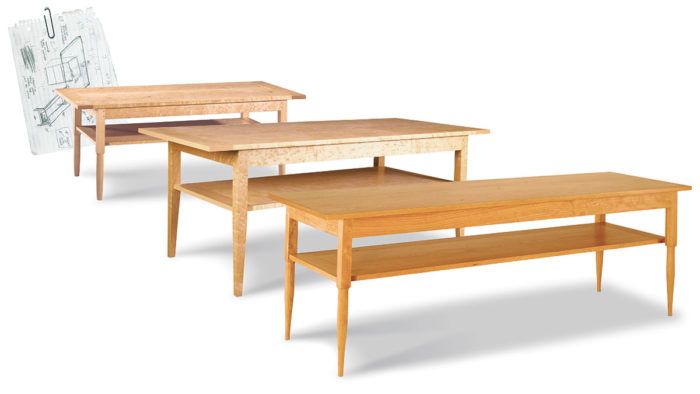Designing on the Go: A Coffee Table Takes Shape
Altering legs, shelf and top leads to a handsome table in the spirit of the Shakers
Synopsis: Peter Turner turned a request from his sister into a design-and-build process that produced four versions of a Shaker-style coffee table. Each version he built improved upon the last, and he explains here how to build a 36-in. by 18-in. table with square, tapered legs. Simple construction complements the design, and he uses citrus oil to finish the piece. Turner tells you how to turn the legs and joints go together. There’s also a list of books on Shaker design.
My sister Wendy offered me a deal I couldn’t refuse. She’d give me one of her watercolor paintings if I made a worktable for her studio. She sent me a rough sketch showing a long, low table with a shelf beneath the top.
Then I started thinking. Why not turn Wendy’s worktable into a prototype for something I could sell as a stock item in my booth at craft shows? Something everyone needs—a coffee table. This barter proved to be the start of a designand-build process that produced four versions of this Shaker-style coffee table and culminated in the table you see in the front photo. It gracefully serves its purpose and is not difficult to build.
Small changes produce big results
Along the way, I tried three different leg designs, three approaches to the shelf and top construction, and several different dimensions on the top. Wendy’s worktable, at 20 in. high, was a little too tall to correspond to most sofas. I lowered the second version to 18 in. and added a 48-in. by 23-in. top. The legs, turned from 13⁄8-in. stock, were slightly tapered and ended at 15⁄16 in. at the floor (see the back table). Both the top and the shelf had breadboard ends. Although very useful, the table’s narrow width reminded me of an aircraft carrier, and the legs ended up looking like cigars.
A shortened incarnation, 36 in. by 18 in., with square, tapered legs followed (see the center table). I added a more intricate breadboard design, one with multiple tenons, after I read an article by Garrett Hack describing his approach (see FWW #110, pp. 78-81). That was as much to try a new technique as it was to provide more strength and stability.
But some of these design features made the table too expensive. So to make the table easier and faster to build (and as a result less expensive), I reduced its complexity while retaining its usefulness and grace.
From Fine Woodworking #128
For the full article, download the PDF below:
Fine Woodworking Recommended Products

Sketchup Class

Stanley Powerlock 16-ft. tape measure

Drafting Tools





















Log in or create an account to post a comment.
Sign up Log in